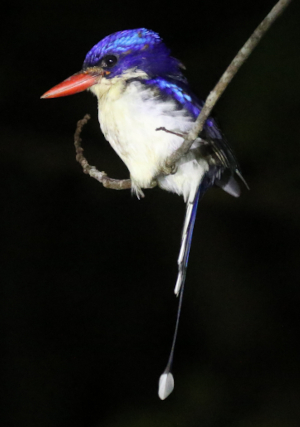- Tanysiptera galatea
Identification
33–43 cm
- upperparts dark blue
- underparts white
- crown irridescent blue
- central tail feathers long, blue tipped with white racquets
- bill red
Distribution
Southeast Asia: found in Indonesia, Moluccas, Papuan Islands, Australasia: Papua New Guinea
Taxonomy
Subspecies
There are 15 subspecies [3]. Many of these should probably be better treated as full species [1],[2]. Bioacoustic evidence suggests 6 such taxa (indicated against subspecies below). Aside from acoustic differences, subspecies are mainly distinguished by the shade/intensity of blue and the distribution of white/blue in tail feathers
- T. (g.) doris: "Morotai Paradise-kingfisher". Morotai (northern Moluccas)
- T. g. emiliae: "Morotai Paradise-kingfisher". Rau (Moluccas)
- T. g. browningi: "Halmahera Paradise-kingfisher". Halmahera (northern Moluccas)
- T. g. brunhildae: "Halmahera Paradise-kingfisher". Doi (Moluccas)
- T. g. sabrina: "Halmahera Paradise-kingfisher". Kayoa (northern Moluccas)
- T. (g.) margarethae: "Halmahera Paradise-kingfisher". Bacan (northern Moluccas)
- T. (g.) obiensis: "Obi Paradise-kingfisher" Central Moluccas (Obi and Bisa)
- T. g. acis: "Amboyna Paradise-kingfisher". Buru (southern Moluccas)
- T. g. boanensis: "Amboyna Paradise-kingfisher". Boano (Moluccas)
- T. (g.) nais: "Amboyna Paradise-kingfisher". Southern Moluccas (Ambon, Manipa, Seram, Manawoka, Gorong)
- T. (g.) galatea: "Papuan Paradise-kingfisher". North-western New Guinea and western Papuan islands
- T. g. meyeri: "Papuan Paradise-kingfisher". Northern New Guinea (Mamberamo River to Jimi River Valley)
- T. g. minor: "Papuan Paradise-kingfisher". Southern New Guinea (Digul River to Kumusi River) and Darnley Island
- T. g. vulcani: "Papuan Paradise-kingfisher". Manam Island (off Papua New Guinea)
- T. (g.) rosseliana: "Rossel Paradise-kingfisher". Rossel Island (Louisiade Archipelago)
Habitat
Lowland moist forests, rainforest and monsoon forest.
Behaviour
Diet
The diet includes earthworms, snails, centipedes, beetles, grasshoppers, caterpillars, and lizards.
Breeding
Monogamous. They excavate a nest chamber in the nests of arboreal termites; 5 eggs are laid and incubated by both sexes who care for the young.
Vocalisation
Call: 1-4 long whistles, ending with a loud trill.
References
- Eaton, J.A.. van Balen, B. Brickle, N.W., B Rheindk F.E. (2021). Birds of the Indonesian Archipelago, Greater Sundas and Wallacea. Lynx Edicions. Barcelona. Second Edition
- Sin, Y. C. K., Eaton, J. A., Hutchinson, R. O., and Rheindt, F. E. (2022) Re-assessing species limits in a morphologically cryptic Australasian kingfisher lineage (Coraciiformes: Halcyonidae) using bioacoustic data. Biological Journal of the Linnean Society. 136(4): 489–505. https://doi.org/10.1093/biolinnean/blac047
- Clements, J. F., T. S. Schulenberg, M. J. Iliff, T. A. Fredericks, J. A. Gerbracht, D. Lepage, S. M. Billerman, B. L. Sullivan, and C. L. Wood. 2022. The eBird/Clements checklist of Birds of the World: v2022. Downloaded from https://www.birds.cornell.edu/clementschecklist/download/
- Avibase
- Answers.com
Recommended Citation
- BirdForum Opus contributors. (2025) Common Paradise Kingfisher. In: BirdForum, the forum for wild birds and birding. Retrieved 3 May 2025 from https://www.birdforum.net/opus/Common_Paradise_Kingfisher
External Links
GSearch checked for 2020 platform.1





